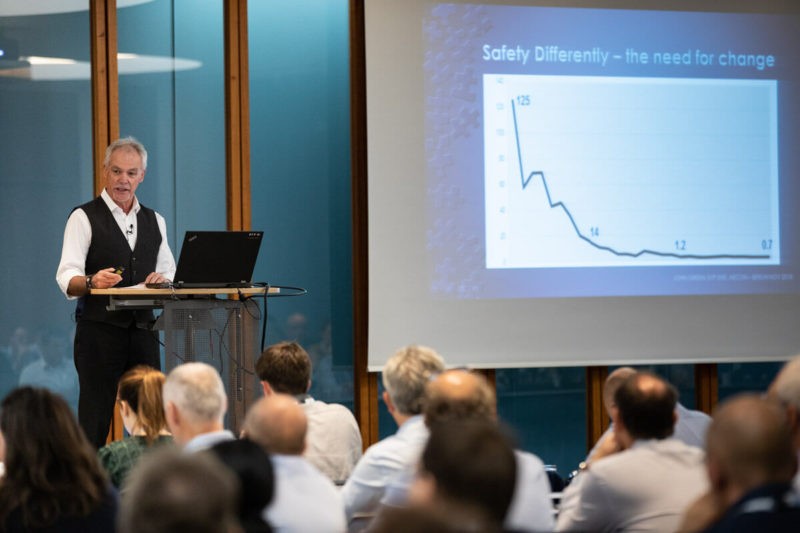John Green, Health and Safety Director at AECON discusses what Safety Differently is and why he feels there is a need for change.

More organisations are starting to realise that being good at safety today doesn’t mean that you are immune from the disasters of tomorrow. Many have concluded that while the established way of doing safety may have delivered impressive results in terms of accident rates, this approach is exhausted, impotent and incapable of continuing to deliver further improvements in performance. Indeed, many are seeing little improvement in accidents rates overall while some are experiencing a rise in accidents and events that are serious. These concerns are reflected in national safety statistics.
These organisations are experiencing first-hand the problematic unintended consequences of focusing on a strategy that is based upon controlling and constraining the workforce and seeing safety as the absence of accidents. It seems perverse that when we want more safety we continue to measure the things that we want less and less of.
Consequently, these organisations are seeking a ‘new way’ – a way that blends the successes of previous approaches with an acknowledgement that the world of work has and continues to change at an astonishing rate and that safety must respond accordingly.
But organisations are inherently cautious and conservative. Change is daunting. The status quo has a powerful inertia. We need to accommodate this caution and somehow respond to these fears.
There is no one size fits all to this, no silver bullet. The organisations that I have worked with have all found different ways of doing this. But these different ways have all been variations on a theme.
I have found that working with different companies, in different sectors across the world, that there are some areas of commonality in terms of approach and some useful pointers on where to start and how to proceed. So, while this will not be a “here’s one I prepared earlier,” I do intend to offer some guidance and examples of where you might want to head during this series of articles.
Throughout the series, I will probably switch between Safety Differently, Safety 2.0, the ‘new view’ and perhaps a couple others. Although there may be slight and subtle differences between these definitions and approaches for our purposes they are one and the same.
The need for change
Organisations that are interested in trying something different are already pretty good at safety – if your definition of good is low, reported incident rates. But being good brings with it its own problems.
With less and less going wrong there is less and less to learn from. Furthermore, there are problematic side effects with focusing on negative event rates.
This approach can drive mistrust, alienation and can lead to deceit and utterly inappropriate management strategies when it comes to reporting. In financial circles this would be known as fraud.

Avoiding harm is in our DNA
Organisations will often find themselves facing ever decreasing numbers of accidents giving rates that approach but never quite get to zero. Its shows a strategy that is no longer working. There are those that would argue that because there are days we have no accidents this shows that zero harm is achievable. I’m happy to celebrate accident free days – I think they are terrific, but I don’t think we have achieved them through good safety management alone. It’s equally likely that luck, poor reporting or an oppressive culture has had its say. Imagine claiming that we could understand the basis of a happy marriage by studying only divorced couples.
So, what do you do? Is it about more of the same, the hunt for more and ever less significant deviations, this constant war on error, waiting for something to break and fixing it? Or is at about understanding why things go right and amplifying the capacity of the business to do this more often?
The answer seems obvious but for some reason we struggle to see this. Perhaps it’s because as a race we are genetically programmed to avoid harm – it’s in our DNA. But the things that hurt us as cavemen are not the things that harm us today. Harm is a much more complex construct than it was.
It’s important to realize that failure and success are two sides of the same coin.
What is Safety Differently?
People are the solution they are not the problem
- People create success far more often than they are involved in failure;
- Recognises difference between work as done and work as planned;
- Allows mature conversations around risk to occur;
- Recognises that people are a source of innovation and insight.
Safety is the presence of positives not the absence of negatives
- Absence of accidents does not indicate presence of safety;
- Safety must be about capacity to adapt, tolerate change, be resilient and recover;
- Serious incidents are preceded by long periods of accident free operation.
Safety is an ethical responsibility not a bureaucratic activity
- Systems manage safety not liability;
- Lean management systems enable effective risk management;
- Systems are designed to promote relationships and not transactional.
The Safety Conversation Podcast: Listen now!
The Safety Conversation with SHP (previously the Safety and Health Podcast) aims to bring you the latest news, insights and legislation updates in the form of interviews, discussions and panel debates from leading figures within the profession.
Find us on Apple Podcasts, Spotify and Google Podcasts, subscribe and join the conversation today!



